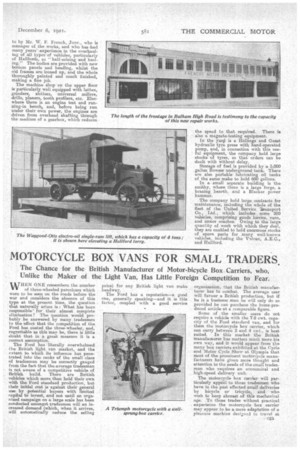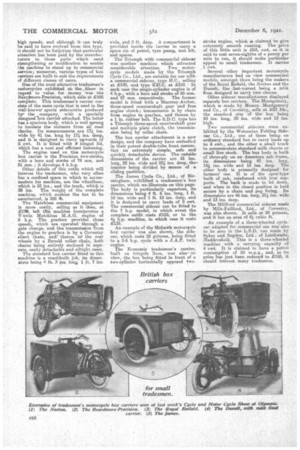MOTORCYCLE BOX VANS FOR SMALL TRADERS,
Page 21

Page 22

If you've noticed an error in this article please click here to report it so we can fix it.
The Chance for the British Manufacturer of Motor-bicycle Box Carriers, who, Unlike the Maker of the Light Van, Has Little Foreign Competition to Fear.
WHEN ONE remembers the number of three-wheeled parcelcars which were to be seen on the roads before the war and considers the absence of this type at the present time, the question that naturally arises is : What has been responsible' for their almost complete elimination? The question would probably be answered by many tradesmen to the effect that the competition of the Poet' has ousted the threeswheeler, and, regrettable as this may be, there is little
doubt that in great measure it is a correct assumption.
The Ford has literally overwhelmed 1 he British light van market, and the extent to Which its influence has penetrated into the ranks of the small .class of tradesman may be correctly gauged from the fact that the overage tradesman is not aware of a competitive vehicle of British build. There are British vehicles which more than hold' their own with the Ford standard production, but their initial. cost is against their general use by potential buyers with limited eapital to invest, and not until an organized campaign on a large scale has been conducted amongst tradesmen will an increased demand (which, when it arrives, will automatically reduce the selling
price) for any British light van make headway.
The Ford has a reputation—a goad one, generally speaking—and it is this factor, coupled with a good service organization, that the British manufacturer has to combat. The average user will favour a British production, but if he is a business man he will only do so provided he can purchase the home-produced article at a comparable figure.
Some of the smaller users do net require a vehicle with the 7-8 cwt. caacity of the Ford standard van, and for them the motorcycle box carrier, which can carry between 2 and 4 cwt., is best suited. In this market the British manufacturer has matters much more his own way, and it would appear from the many box carriers exhibited at the Cycle and Motor Cycle Showat Olympia that most ef the prominent motorcycle manufacturers have given more thought and attention to the needs of the small tradesman who requires an economical and high-speed delivery unit.
The motorcycle box cwrier will particularly appeal to those tradesmen who have in the past effected small deliveries by bicycle or tricycle, and who wish to keep abreast of this mechanical age. To those trades without practical experience the motorcycle box carrier may appear to be a. mere adaptation of a pleasure machine desizned to travel at. high speeds, and although it can truly be said to have evolved • from this type, it should not be forgotten that particular attention has been paid by the manufacturers to thoee parts which need strengthening or modification to enable the machine to stand up to commercial service; moreover, various types of box carriers are built to snit the requirements of different classes of users.
One of the most attractive tradesman's motorcycles exhibited at. the, Shaw in repaid to value for money was the Beardmere-Peecision, which sells at £105 complete. This tradesman's carrier consists of the same cycle that is used in the well-known' sports eidecarette produced by/ the eicanpany; with a specially designed-box carrier attached. The latter has a spacious body, which is well sprung to insulate the contents from all mad shocks. Its measurements are 171 ins. wide by 41 ins, long by 171 ins, deep, and it, is designed to carry upwards of 2 cwt. It is fitted with if lunged lid, which has a neat and efficient fastening. The engine used on this motorcycle box carrier is the Precision two-strolse, with a bore and stroke of 74 mm. and 81 aim. ; it develops 4 b.h.p.
Other details of this outfit which will interest the tradesman, who very often has a confined space in which to accommodate his machine, are the wheelbase, which is 55 ins., and the track, which is 39 ins. The weight of the complete machine, which enables the tax to be ascertained, is 228 IL
The Matchless commercial equipment is 11101* costly, selling as it does, at 2170, bdt this machine incorporates a V-twin Matchless M.A.G. engine of 8 h.p. The gearbox provides three speeds, which are operated through a gate change, and the transmission •frona the engine to gearbox is by a Coventry silent chain, and' thence tol the rear wheels by a RenoId roller chain, both chains being entirely -enclosed in separate, easily detachable and oiltight cases. The standard box carrier fitted to this machine is a coachbuilt job, its dimensions being 11. ft. .3 ins. long 1 ft. 7 ins.
wide, and 2 ft. deep. A compartment is provided inside the Carrier to carry a spare tin of petrol, tyre pump, tool kit, and spares.
The Triumph with commercial' sidecar was another machine which attracted considerable attention. Two motorcycle models made by the Triumph Cycle Co., Ltd., are suitable for use with a commercial sidecar, type B.C., selling at £140, and type S.D.C. at £150. • In each case the single-cylinder engine is of 4 h.p., with a bore and stroke of 85 mm. and 97 mm. respectively. The former model is fitted with a Sturmey-Archer, three-speed countershaft gear and free engine clutch; transmission is by chain from engine to gearbox, and thence by a, 1 in. rubber belt. The S.D.C. type has a Triumph three-speed countershaft gear and multiple plate clutch, the transmission being by roller chain.
The box carrier attachment is a new design, and the company have embodied in their patent double-tube front connection an extremely simple, safe and quickly detachable device. The outside dimensions of the carrier are 51 ins. long, 22 ins, wide and 221 ins, deep, theinterior being divided by means of a sliding partition.
The James Cycle Co., Ltd., of Birmingham, exhibited a tradesman's box carrier, which we illustrate on this page. The body isparticularly capacious, its dimensions being 4 ft. 6 ins, long, 1 ft. 10 ins, wide and 1 ft. 10 ins, deep, and it is designed to carry loads of 2 cwt. The commercial sidecar can be fitted to the 7 h.p. model, in which event the complete outfit costs £155, or to the
h.p. machine, in which case it costs £135.
An example of the Mohawk motorcycle box carrier was also shown, the sidecar, which costs 22 guineas, being fitted to a 5-6 h.p. cycle with a J.A.P. twin engine.
The Economic tradesman's carrier, built on tricycle lines, was also—on view, the box )icing fitted in front of a two-cylinder horizontally opposed two
stroke engine, which is claimed to give extremely smooth running The price of this little unit is £63, and, as it is said to cost seven-eighths of a penny per mile to run, it should make particular appeal to small tradesmen. It carries 1 cwt.
Several other important motorcycle manufacturers had on view commercial models, amongst these being the makers of the Royal Enfield, the Norton and the Denelt, the lest-named being a milk float designed to carry two churns. Other sidecar manufacturers displayed separate box carriers. The Montgomery, which is made by Messrs. Montgomery and Co., of Coventry, sells at £23 10s., the standard size of the box being 60 ins_ long, 20 ins, wide and 18 ins.. high.
Two commercial sidecars were exhibited by the Watsonian Folding Sidecar Co., Ltd. one of these being an ordinary stand:1,rd box to carry loads up to 3 cwt., and the other a small truck to accommodate standard milk churns or small live stock. The box body is built of three-ply on an American ash frame, its dimensions being 47 ins. long, 181 ins, wide and 15 ins. deep. The other body is primarily designed for farmers' use. It is of the open-type built of oak, reinforced with iron supports. The back is made to let down, and when in the closed position is held secure by a chain and peg fixing. Its dimensions are 46 ins, long, 211 ins, wide and 13 ins. deep.
The Millf mei commercial sidecar made by Mills-Full!ord, Ltd., of Coventry, was also shown. It sells at 20 guineas, and it has an area of 81 cubic ft.
An example of a three-wheeled cyclecar adapted for commercial use was also to be seen in the L.S.D. van made by Sykes and Sugden, Ltd., of Linthwaite, Hudderefield. This is a three-wheeled machine with a carrying capacity of 4 cwt. It is claimed to have a petrol consumption of 50 m.p.g., and, as its price has just been reduced/ to 2165, it should interest many tradesmen.
































